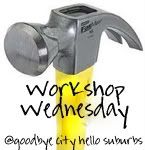When we remodeled our kitchen, we left space for a bigger refrigerator, in case we ever upgrade. That space has just collected clutter for the past 3 years, until now.
Last week, Karen and I spent one day (and a couple margarita filled hours of painting) and built this pull out pantry.

That’s right. WE did it.
By ourselves. No men involved.
We think we’re pretty awesome.
Want to build your own pull out pantry?
Supplies:Wood – we used cheap pine (6 1x8x6 ft boards)
1-1/2 Inch Wood Screws
3/8 inch wood dowels
cordless drill
drill bits to predrill holes
3/8-Inch Drill Bit
4 2-Inch Casters
carpenter's square
pencil
primer
paint
margaritas (optional)
1. Measure and determine how big you want your cabinet to be. We decided it would be as deep and tall as the fridge – 30 inches deep and 64 1/2 inches tall. My space was 9 inches wide, so we used 1x8s (which are actually 3/4 inch by 7 1/2 inch, roughly.) Then, we took an inch off the height because we didn’t want the front/back boards to drag on the floor.
2. Measure and cut the boards. We used a compound miter saw
Our measurements:
2: 63 1/2 in boards (64 1/2 – 1 inch)
8: 28 1/2 in boards (30 minus the width of the front and back boards)
14: 29 inch dowels (the dowels need to be slightly longer than the shelves so they will stay in their little “pockets.”)
3. Pour margaritas. Prime and paint.

4. Mark holes for screws and dowels. (Best to do this the next morning, after the margaritas have worn off.)
I actually laid the back board on the floor, and laid groceries on top of it to decide the spacing of the shelves. We wanted heavier things at the bottom, so that the finished cabinet would be less likely to tip. I’m writing this post with a sleeping baby on my lap, and I don’t have the exact measurements, but we ended up with something like two 15 inch shelves, two 10 inch shelves, two 8 inch shelves and a 6 inch shelf. Or something.
5. We predrilled the holes for the screws, and made the holes for the dowels. The holes for the dowels are 2 inches up from the shelf, and 3/4 inch from the edge. They are 1/4 inch deep. (We put blue tape on the drill bit at 1/4 in so we knew how deep to go.)

6. Assemble:
We put two screws per shelf, although if it were wider, we would have used more. And we totally would have just used the nail gun, but again, not in our repertoire.

That’s Karen, popping in the dowels.

7. Screw casters to the bottom, and pack with groceries!!!


(See how that front board hangs in front of the caster, but doesn’t touch the floor? That way, you don’t see the casters from the front.)
Left to do:
1. Finish the front. I’m thinking about putting a nicer piece of wood on the front, or some molding, and a handle. Not sure yet.
2. Figure out a way to stop it from being pulled too far. I don’t want it to come farther than the wall/fridge, because that way it won’t tip on my babies.
3. Deal with the uneven floors that come with 100 year old farmhouses. When you push the shelf in all the way, it tips, and that drives me nuts. I may install a drawer glide thingy along the top shelf that will help with both #2 and #3.
4. My dad thinks it needs a “back.” I think maybe a diagonal brace across the back. eh. We’ll see.
What do you think? Have you ever built something without the aid of menfolk? We had a blast doing it, and we’re giddily proud of ourselves!
Piece of Work Wednesday











